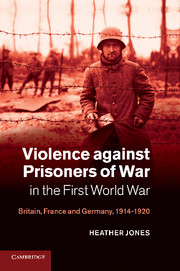Book contents
- Frontmatter
- Contents
- List of illustrations
- List of tables
- Acknowledgements
- Abbreviations
- Introduction
- Part I Propaganda representations of violence against prisoners
- Part II Violence and prisoner of war forced labour
- Part III The end of violence? Repatriation and remembrance
- 6 Contested homecomings: prisoner repatriation and the formation of memory, 1918–21
- 7 La Grande Illusion: the interwar historicisation of violence against prisoners of war, 1922–39
- Epilogue: the legacy of First World War captivity in 1939–45
- Conclusion
- Glossary of foreign terms
- Bibliography
- Index
7 - La Grande Illusion: the interwar historicisation of violence against prisoners of war, 1922–39
Published online by Cambridge University Press: 05 January 2014
- Frontmatter
- Contents
- List of illustrations
- List of tables
- Acknowledgements
- Abbreviations
- Introduction
- Part I Propaganda representations of violence against prisoners
- Part II Violence and prisoner of war forced labour
- Part III The end of violence? Repatriation and remembrance
- 6 Contested homecomings: prisoner repatriation and the formation of memory, 1918–21
- 7 La Grande Illusion: the interwar historicisation of violence against prisoners of war, 1922–39
- Epilogue: the legacy of First World War captivity in 1939–45
- Conclusion
- Glossary of foreign terms
- Bibliography
- Index
Summary
We three can do nothing until we meet again.
Inscription on a British prisoner of war grave at Kassel-Niederzwehren Commonwealth War Graves Cemetery, Kassel, Hessen, Germany.Rauffenstein: I do not know who is going to win this war, but I do know one thing: the end of it, whatever it may be, will be the end of the Rauffensteins and the Boeldieus.
De Boeldieu: But perhaps there is no more need of us.
Extract from the film La Grande Illusion, directed by Jean Renoir, 1937.Introduction
Up until 1921, discourses on violent prisoner treatment, often based on real wartime events, continued to dominate in Britain, France and Germany; the experience of prisoners whose captivity was uneventful was largely excluded from public discussion. However, the following years saw a cultural shift away from this emphasis upon violence against prisoners. Almost all of the wartime references to prisoners of war explicitly or implicitly related acts of violence by the enemy towards them; yet by the early 1930s, the mistreatment of prisoners of war had become a marginal issue. This was in a large part due to a change in the public mood in the mid-1920s in favour of European reconciliation: emphasising wartime violence by the enemy against helpless captives became incompatible with the new pacifist consensus, which promoted dismantling wartime hatreds. To re-engage with the former enemy in peacetime, it proved necessary to forget their wartime prisoner mistreatment.
- Type
- Chapter
- Information
- Violence against Prisoners of War in the First World WarBritain, France and Germany, 1914–1920, pp. 315 - 355Publisher: Cambridge University PressPrint publication year: 2011

